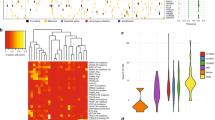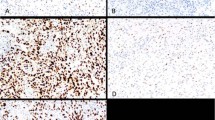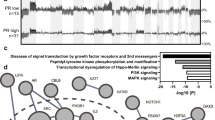Abstract
Mouse monoclonal antibodies PAb 240 and PAb 1801 which specifically immunoprecipitate p53 protein, were used to examine 27 fresh ovarian tumours (16 serous adenocarcinomas, six endometrioid carcinomas, one mucinous adenocarcinoma, one mucinous borderline tumour and three benign adenomas). Eleven out of 16 (69%) serous adenocarcinomas and one endometrioid tumour showed positive staining with one or both antibodies and none of the mucinous or benign tumours stained with either antibody. DNA from tumour and peripheral blood leukocytes was used to identify allelic deletions on chromosome 17p in tumours. 11/12 positively staining tumours showed less of heterozygosity (LOH) on 17p at the nearest informative locus to the p53 gene. In this series of ovarian tumours, LOH on 17p correlates closely with the aberrant expression of the p53 protein in a high proportion of advanced stage serous adenocarcinomas. This observation suggests that the p53 tumour suppressor gene is involved in the evolution of epithelial ovarian cancer (EOC) and may have prognostic significance.
This is a preview of subscription content, access via your institution
Access options
Subscribe to this journal
Receive 24 print issues and online access
$259.00 per year
only $10.79 per issue
Buy this article
- Purchase on Springer Link
- Instant access to full article PDF
Prices may be subject to local taxes which are calculated during checkout
Similar content being viewed by others
Author information
Authors and Affiliations
Rights and permissions
About this article
Cite this article
Eccles, D., Brett, L., Lessells, A. et al. Overexpression of the p53 protein and allele loss at 17p13 in ovarian carcinoma. Br J Cancer 65, 40–44 (1992). https://doi.org/10.1038/bjc.1992.8
Issue Date:
DOI: https://doi.org/10.1038/bjc.1992.8
This article is cited by
-
Potentially important microRNA cluster on chromosome 17p13.1 in primary peritoneal carcinoma
Modern Pathology (2009)
-
Patterns of expression of chromosome 17 genes in primary cultures of normal ovarian surface epithelia and epithelial ovarian cancer cell lines
Oncogene (2003)
-
Atypical epithelial changes and mutant p53 gene expression in ovarian endometriosis
Pathology & Oncology Research (2001)
-
Functional evidence for an ovarian cancer tumor suppressor gene on chromosome 22 by microcell-mediated chromosome transfer
Oncogene (2000)
-
Laser Capture Microdissection–Guided Fluorescence In Situ Hybridization and Flow Cytometric Cell Cycle Analysis of Purified Nuclei from Paraffin Sections
Modern Pathology (2000)



